The “British” Army that laid siege to Fort Stanwix in August of 1777 was the brainchild of British General John Burgoyne, who wished for an independent command when his superior, Canadian Governor and General Guy Carleton renewed his offensive against the Americans on Lake Champlain in the summer of 1777. Burgoyne proposed leading a large force of British regulars in a diversionary attack down the Mohawk Valley. When his political maneuvering in the winter of 1776-1777 led to him supplanting Carleton as the commander of the main army of invasion however, Burgoyne’s views of the Mohawk Valley expedition changed radically. Wanting to now maximize the main army, Burgoyne justified in his own mind that the Americans could not possibly still have the larger forces that had been on the Mohawk in 1776. In addition, Burgoyne had met with Guy Johnson, the Superintendent of Indian Affairs, who was also in London that winter. Johnson assured Burgoyne that the Six Nations Indians and Mohawk Valley Loyalists were only awaiting the arrival of British troops to then turn out in large numbers for the king. All this would lead Burgoyne to reduce the Mohawk Valley force to an army light in British troops and artillery, that would be counting on large numbers of Indians and Loyalists to swell its numbers.
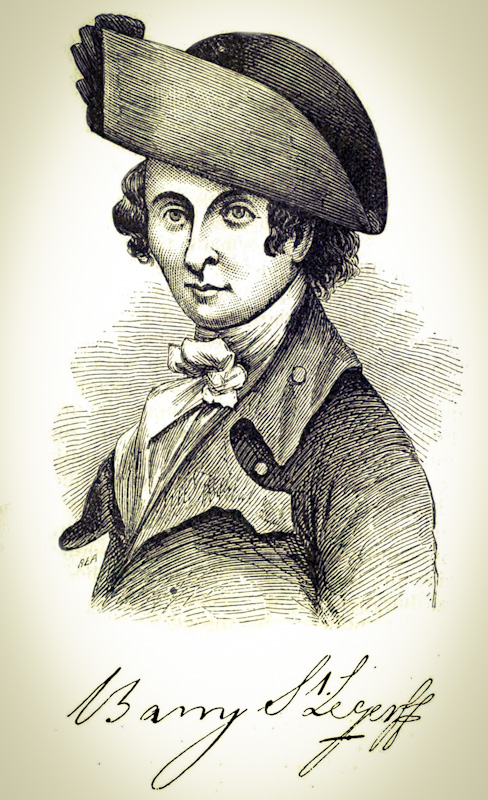
ABOVE: A period image of the man believed to be Barry St. Leger. In recent years, the validity of the ID has been questioned.
Burgoyne specifically requested Lieutenant Colonel Barry St. Leger of the 34th regiment to command the Mohawk Valley expedition. While St. Leger had proven to be a competent officer with experience in North America during the French and Indian War, he had never worked in combined operations with Indians before. This made him a somewhat odd choice for command of a force that would be relying heavily on Indian forces. To give him a more proper rank to command the expedition, St. Leger was given the rank of Brevet (temporary) Brigadier General. Unfortunately, St. Leger was to multiply Burgoyne’s mistakes concerning the Mohawk Valley force. Chief of these mistakes was his mistrust of his Loyalist and Indian allies. St. Leger was initially acting on old British intelligence that reported Fort Stanwix was still in a ruinous state and only lightly defended. When he received current information from his Loyalist and Indian scouts that the fort was mostly rebuilt and heavily manned, he still had time to request more and heavier cannons, as well as to wait for two additional companies of German riflemen who had not yet arrived. In the end, St. Leger would discount this new information and proceed forward. Later in the siege, his Loyalist officers pressed him to continue down the Mohawk after the Battle of Oriskany, knowing that the militia would not be able to rise again. St. Leger disregarded this advice and chose to continue the siege of the fort. No doubt St. Leger’s judgement was also clouded with the typical British egotism that the poorly trained and equipped Americans could never ultimately stand against the might and professionalism of the British military.
St. Leger’s army would ultimately be composed of the following detachments:
British 34th and 8th Regiments (100 men from each regiment)
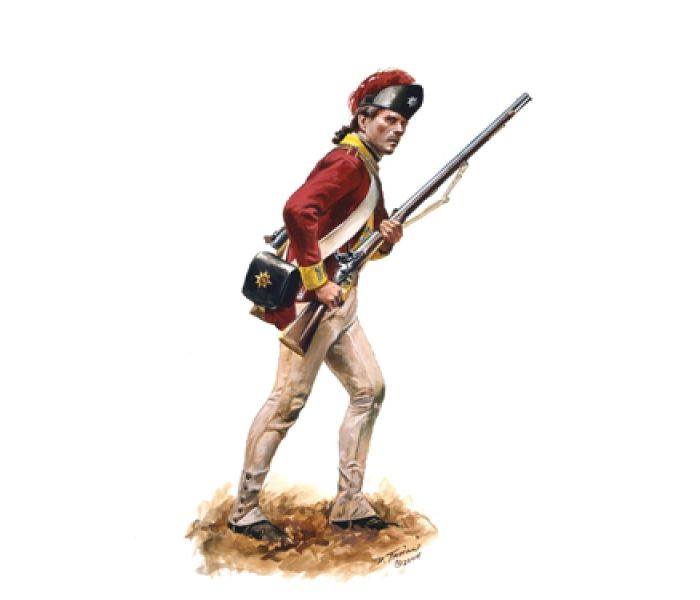 ABOVE: A British soldier from the 34th Regiment of Foot. Image by Don Troiani.
ABOVE: A British soldier from the 34th Regiment of Foot. Image by Don Troiani.
The 34th Regiment was St. Leger’s regiment and had come to Canada as part of the British reinforcements in the spring of 1776 that helped to drive the Americans out of Canada. During the siege, the 34th detachment would make up part of the main British encampment around a ½ mile northeast of the fort. The two companies of the 34th would also attempt to block Lt. Col. Marinus Willett’s force from returning to the fort after their successful raid on the Indian and Loyalist camps on the afternoon of August 6th. This attempt failed and Willet’s force made it into the fort without the loss of a single man.
The 8th regiment had been sent to North America in 1774 to man the various British posts that ran along the modern-day U.S.-Canadian border from Ogdensburg, N.Y. in the east to modern day Michigan in the west. Due to the many years of garrison duty, the officers had to pick and choose carefully amongst the regiment to find men that were still young, healthy, and fit enough to go on campaign with St. Leger’s army. During the siege of the fort, part of the 8th detachment would occupy the area of the lower landing of the Mohawk River about ½ mile east of the fort. This detachment was sent on a wild goose chase towards Oriskany by an Oneida Indian on the afternoon of August 6th. Posing as a British allied Indian, the Oneida reported that additional troops were needed to defeat Herkimer’s militia at Oriskany. With this British detachment out of the way, Lt. Col. Willet was free to attack the Indian and Loyalist camps without opposition. The rest of the 8th detachment made up the main British camp and assisted the 34th regiment in the failed attempt to block Willett’s force from returning to the fort.
Detachment from The Royal Artillery Regiments (42 men)
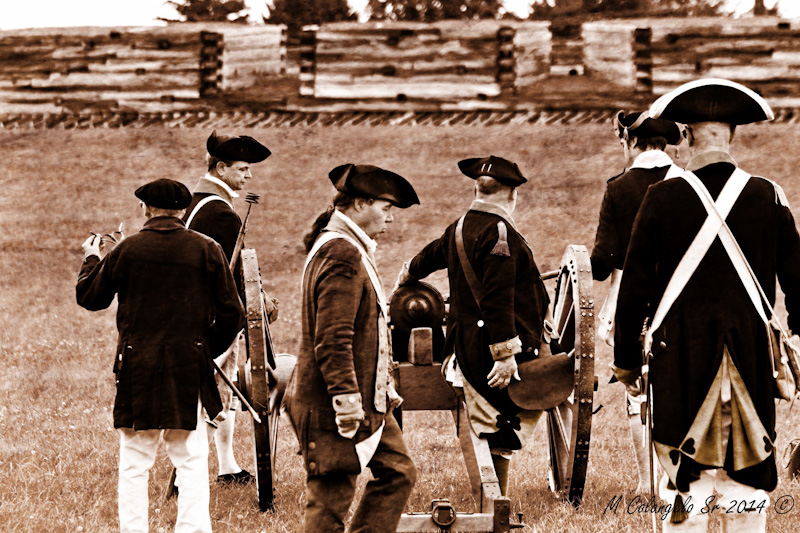
ABOVE: Reenaactors from the park dressed as a detachment of Royal Artillery. Image courtesy of M. Colangelo.
St. Leger’s decision to not send for bigger guns while still in Canada meant that this detachment would arrive at the fort with 4 small cannons and four small mortars. The two 3 pounder and two 6 pounder (named for the weight of the cannonball they fired), cannon could not damage the walls of the fort in any way. While the 4 small mortars could throw exploding shells down inside the fort, the shells were too small to start large scale fires, kill or wound large numbers of the American defenders, or do major damage to the fortifications. In a gross oversight on someone’s part, carcass shot, which was designed specifically to explode and start fires in wooden structures, had not been included in the artillery’s ammunition stores. In addition, the actual skill of the artillerymen also came into question as it was noted by the commander of the German detachment that most of the shells fired at the fort sailed over it and exploded on the other side. Indian observers commented that the ineffective artillery fire reminded them of “Apples that Children were throwing over a Garden Fence.” During the bulk of the siege, the 6 Pounder Cannon were about 600 yards northeast of the fort, and the mortars were set up on a hill just a short distance behind the cannon. During the final days of the siege, the British attempted to get their mortars close enough to fire exploding shells directly against the walls of the fort. This resulted in them getting within 150 yards of the Northwest bastion (corner) of the fort, but the siege ended before the experiment could be tried. In the end, all the British cannons and mortars were abandoned during St. Leger’s retreat from the fort.
Hesse Hanau Jager Company (89 men)
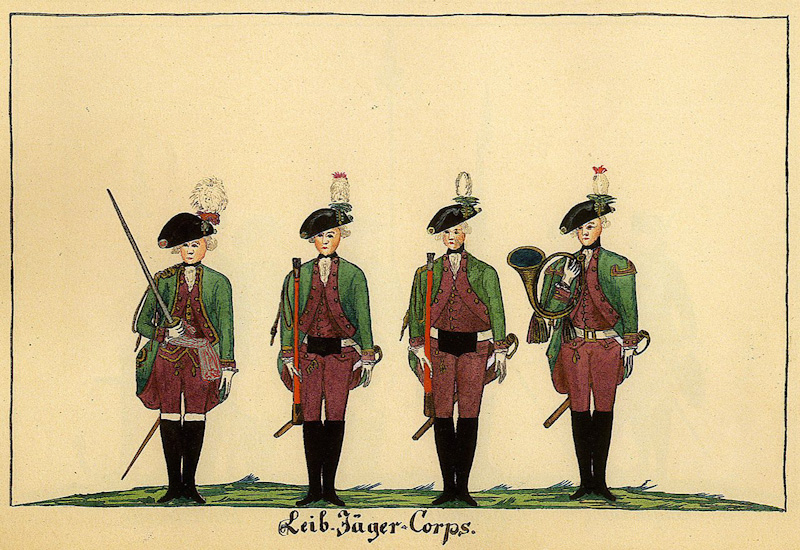 ABOVE: Period image of the Hesse Hanau Jägerkorps.
ABOVE: Period image of the Hesse Hanau Jägerkorps.
One of the many German regiments hired by the English government to augment their army, only one company arrived in Canada in time to join St. Leger. Jaegers (German for hunters), came from the woodsmen, hunters and gamekeepers of the various German states and carried rifles rather than muskets and bayonets. They were traditionally employed as scouts and skirmishers, and during the siege of the fort as snipers. Several of the Americans defenders who continued to repair the fort walls after the siege started were killed and wounded by these Jaeger riflemen. A detachment of Jaegers was also sent with the Loyalists and Indians to ambush Herkimer’s militia at Oriskany. During the British retreat from the fort, St. Leger ordered the Jaegers to be the rear guard of the army. This resulted in several of them being beaten and/or killed by St. Leger’s frustrated Indian allies who attacked them for their weapons and equipment.
The King’s Royal Regiment of New York (133-204 men)

ABOVE: Reenactors dressed as soldiers of the King's Royal Regiment of New York. Image courtesy of royalyorkers.ca
This Loyalist regiment was raised by Sir John Johnson in June of 1776, and was composed largely of men from the Mohawk, Schoharie and Cherry Valley area. Sir John was the son of the former Superintendent of Indian Affairs, Sir William Johnson. While he did not follow in his father’s footsteps into the Indian department, he did inherit all his father’s vast holdings and was easily the wealthiest man in the Mohawk Valley. He also still held a great deal of influence over the Six Nation’s Indians as the son of their beloved former superintendent. Combining this with his connections to and knowledge of the people of the Mohawk Valley, he was the perfect choice to act as St. Leger’s second in command. The success of the expedition would not only forward British goals but would also allow Sir John and many of his men to reclaim their homes and holdings and be reunited with their families. During the siege, The King’s Royal Regiment of New York (KRRNY) encamped in the area between the upper and lower landings of the Mohawk river, about 1/4 to 1/2 miles south and east of the fort. Two detachments of the regiment fought at Oriskany and Sir John was in overall command of the Loyalist/Indian forces at the battle. It was the KRRNY’s camp in conjunction with the main Indian camp that bore the brunt of Lt. Col. Willet’s attack on the afternoon of August 6th. Sir John had returned to his camp to dispatch reinforcements to Oriskany and was caught up in the attack. He and his family were able to flee to safety but all of his personal military books and papers, and other personal property was captured or destroyed. Sir John was one of the most vocal in attempting to convince St. Leger to advance after the fight at Oriskany, all to no effect. The failure of the expedition meant that Johnson would never regain his home or holdings in the Mohawk Valley.
Canadian Militia Company (54 men)

ABOVE: A painting of men in civilian militia uniforms.
Three companies of Canadian militia were raised specifically for Burgoyne’s and St. Leger’s expeditions after large scale general recruiting failed amongst the French-Canadian population. While the local men were ready to protect their homes and families from invaders, they did not see the need to serve outside of Canada. The company assigned to St. Leger’s expedition was commanded by French Canadian Captain Jean-Baptiste-Melchior Hertel de Rouville, who had served for a time in the French army in Europe and gained considerable experience in irregular warfare. It appears that de Rouville’s company was given little chance to engage in combat during the siege and instead was employed in clearing Wood Creek, guarding the batteaus, and helping to construct defensive works, siege trenches and gun batteries.
British Indian Department Rangers (Approx. 100 men)
 ABOVE: An image of a man dressed as an British Indian Department Ranger.
ABOVE: An image of a man dressed as an British Indian Department Ranger.
The British Indian Department was developed in 1756 under Sir William Johnson, the first superintendent of Indian affairs. The department eventually grew to take in not only the 13 colonies, but Canada and out into the Great Lakes region as well. Originally composed primarily of Johnson’s family and close friends, it grew to include men who through personal preference, trade and intermarriage were well versed in Indian cultures and languages. Their main job was to keep the various Indian nations friendly to the British, and during times of war to act as liaisons between the Indian leaders and the British military. On campaign with the Indians, these men often dressed in the mixed white/native clothing style favored by the Indians and at times even painted themselves in the Indian fashion. During the siege of the fort, in addition to their regular duties, the rangers assisted in clearing Wood Creek and a detachment of 20 fought against Herkimer’s militia at Oriskany. In the winter of 1777-1778 the Indian Department Rangers worked hard to maintain Indian allegiance to the crown after the failed siege and Burgoyne’s defeat at Saratoga.
Brant’s Volunteers (Approx. 200 Men)
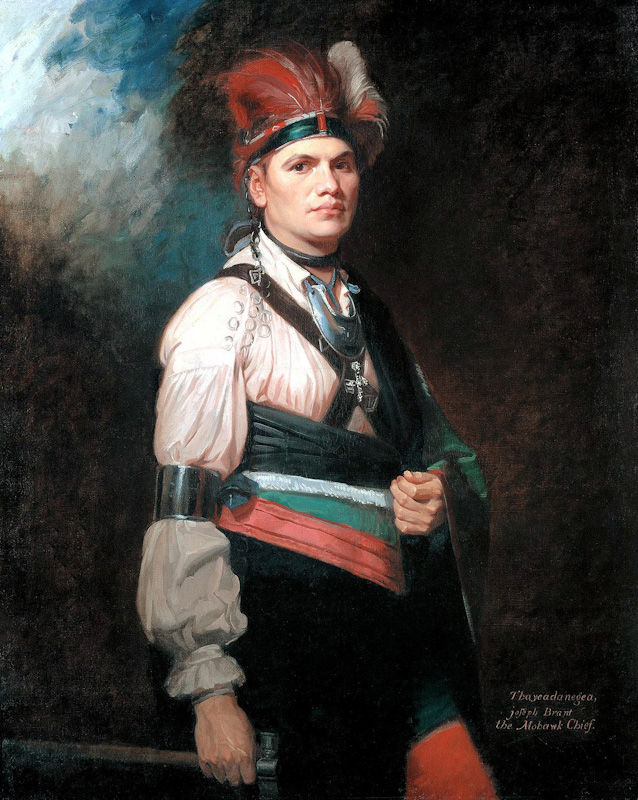 ABOVE: A period image of Joseph Brant painted by George Romney.
ABOVE: A period image of Joseph Brant painted by George Romney.
Joseph Brant was a Mohawk Indian who received patronage from Sir William Johnson after Johnson took Joseph’s sister as his common law wife. Seeing promise in the young man, Johnson ensured Brant was educated and gave him a position as secretary in the Indian department. Due to this upbringing, Brant moved easily back and forth between Indian and white society. He returned to New York in 1776 from a visit to England with assurances that the British government would support the Indians against the colonists. Filled with a burning desire to unite the Six Nations Indian Confederacy in support of the British, Brant’s mission largely failed since he did not hold any recognized authority within the confederacy or even his own Mohawk Nation. Still resolved to do everything in his power to aid the British, Brant raised his own mixed Indian/Loyalist force that successfully terrorized the frontiers of New York on their own and as part of larger raiding parties. Since he never obtained any recognized “rank” within the Six Nation’s Confederacy, The British commissioned him a Captain in the Indian department in 1780 Early histories put Brant in command of the Indian forces during the siege of the fort, but that is incorrect. Brant only ever commanded his own unit. At Oriskany, Brant’s force was given the task of attacking the rear of the militia force and cutting off its escape. In this he was only partially successful as the ambush was sprung early, giving the rear guard of the militia time to flee the battlefield. Many of Brant’s men chose to chase down the fleeing militiamen rather than stay on the battlefield. It cannot be verified but it is suspected that it was Brant’s force that later destroyed the Oneida Indian village of Oriska in retaliation for the Oneidas having joined Herkimer’s men.
Indian Forces (Approx. 700-1000 Men)
St. Leger’s army was heavily dependent on Indian forces to swell its numbers. Since his army was moving along the eastern border of Six Nations Confederacy lands it was assumed by the British that the bulk of the confederacy would join St. Leger’s expedition. The Confederacy had come more and more under the influence and affiliation of the British from the mid 1700’s on due to the work of British Indian superintendent William Johnson. By the end of the French and Indian war, Johnson had secured a firm alliance between the Six Nations and England. The British were quite surprised therefore at the start of the American Revolution when most of the Six Nations favored a neutral stance. The confederacy rightly assessed the situation as a civil war between “Old England and New England” and preferred to stay neutral and then deal with whoever won. Even more alarming to the British, the Oneida Nation showed signs of siding with the Americans if neutrality could not be maintained. Unable to ever reach a unified stance, each individual nation of the confederacy was final forced to make its own individual decision as to which side to support.
It was not until St. Leger’s expedition was well underway that the British were able to persuade many Seneca to join them. A second “grand council” as the expedition neared the fort gained the British the support of most of the Mohawks and small numbers of Cayuga, Onondaga, Oneida and Tuscarora. Two experienced Seneca War Captains, Old Smoke and Cornplanter, were elected as co-leaders of the combined Six Nations forces. Since their homeland was being invaded, almost the entire Oneida Nation and much of the Tuscarora Nation sided with the Americans. The Battle of Oriskany would shatter the centuries old Six Nation’s Confederacy, pitting Seneca, Mohawk and other Six Nations Indians with the British against Oneidas with General Herkimer’s militia. As the siege wore on, the Indians supporting the British grew angrier over their losses at Oriskany, the loss of their camps, and in being restrained from advancing down the valley. Upon hearing that General Benedict Arnold was coming with a relief force of Continental soldiers, the Indians began a mass desertion of the British, causing St. Leger to lose his nerve and end the siege.
